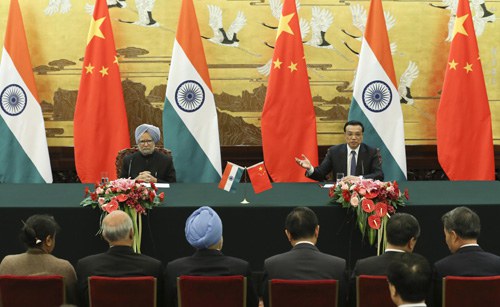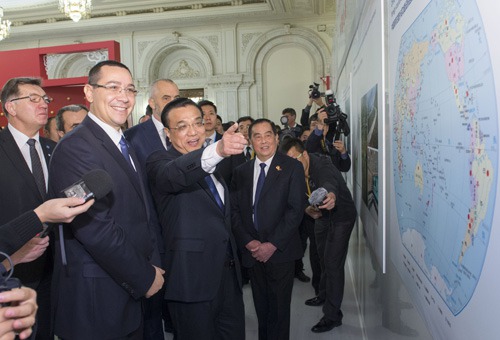 |
|
CLOSER TIES: Chinese Premier Li Keqiang (right) and visiting Indian Prime Minister Manmohan Singh attend a joint press conference in Beijing on October 23, 2013 (DING LIN) |
Neighborhood policies
Relationships with great powers and neighboring countries are the most important elements of China's new diplomatic layout.
To China, Russia has a dual identity as great power and neighbor. Xi chose Russia as the first leg of his first overseas visit as Chinese president in March 2013. This arrangement was interpreted as an attempt to strengthen China's strategic position in the north, and to ease its pressure in the seas to the east. Xi's visit deepened the China-Russia strategic partnership, and strengthened the two sides' common will in pushing forward for a multipolar world. The visit witnessed the signing of a large number of major cooperative agreements on trade, energy, the military industry and aviation.
By December 2013, President Xi had conducted four foreign visits, and Premier Li Keqiang three. They paid visits to 22 countries, including 12 neighbors. Four of the six multilateral summits they participated in were related to regional cooperation in the neighborhood. In 2013, China's relationships and partnerships with neighboring countries, including ASEAN members, Shanghai Cooperation Organization members, India and Pakistan, were greatly enhanced, and their cooperation in trade, finance, energy, security, transportation and culture made great progress.
The CPC Central Committee held a work forum on neighborhood diplomacy in October 2013. Xi pointed out that the neighboring area is of extreme strategic importance to China, and China must be more active in conducting neighborhood diplomacy. He emphasized the policies of "building friendship and partnership with neighboring countries" and "building a community of common interests in the neighborhood."
Relations with Japan and the Philippines were exceptions in the region. The two countries' relationships with China were full of confrontations in 2013 because of their intention of highlighting territorial and maritime disputes. Frictions between China and Japan are more like a geo-strategic competition. Japanese Prime Minister Shinzo Abe took a provocative stance in the disputes between China and Japan, so as to build a case for proceeding with Japan's constitutional amendment, which intends to disentangle Japan from its commitments at the end of World War II. The dispute over the Diaoyu Islands is still unresolved.
 |
|
GOING GLOBAL: Chinese Premier Li Keqiang visits an exhibition of Chinese railways and equipment along with leaders of Central and Eastern European countries in Bucharest, Romania, on November 26, 2013 (LI XUEREN) |
By handling frictions with Japan and the Philippines, China is forming a clear strategy on important issues that concern the country's core interests such as territory and sovereignty. While following the principle of solving disputes through peaceful means like dialogue and negotiations, China should draw a line, build deterrence, prepare for the worst-case scenario, and never allow intentions of undermining China's sovereign rights by ganging up with powers outside the region.
To China and most ASEAN countries, jointly promoting regional economic integration is the key trend of the China-ASEAN relationship while disputes over the South China Sea only concern a few ASEAN countries. Based on the spirit of the Declaration of the Conduct of Parties in the South China Sea, China conducted discussions with ASEAN members over the Code of Conduct in the South China Sea. The Philippines, which intended to hijack the China-ASEAN relationship to fulfill its own ambition, finally found itself isolated.
|
